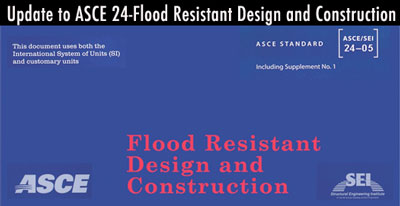
There has been much confusion among contractors, building officials and design professionals in the New Jersey-New York metro area regarding flood design requirements after Superstorm Sandy. The IBC Building Code in New Jersey adopts both ASCE 7 Minimum Design Loads for Buildings and Other Structures and ASCE 24- Flood Resistant Design and Construction as building code adopted flood requirements. ASCE 7 also adopts ASCE 24. In our Sandy related assessment and design work, we have followed the ASCE 24 standard, as it both code adopted and supersedes all other standards, guidelines and recommendations. The ASCE has just released a new version of ASCE 24, ASCE 24-14. This is the first update in nine years since ASCE 24-05. Some significant changes have occurred, including switching to a flood design class, rather than using a risk/occupancy classification, adding requirements for residential portions of mixed use property, clarifying requirements and specifications for flood openings, clarifying requirements for garages, carports and accessory structures, adding a section for parking structures, and, most significantly, clarifying some of the requirements for coastal high hazard areas (V Zones and Coastal A Zones). This has been the source of much of the confusion we have seen regarding flood zone requirements. Flood zones V and Coastal A are areas designated on the FEMA flood map as being subject to impact from wave action. The foundation and elevation requirements in these zones are significantly more extensive and costly than in areas subject only to rising and falling static water. The determination of whether or not a property is in a Coastal A or V zone, as well as what the requirements of those zones are, has caused many an issue on a project as it greatly affects the nature and cost of the project. The Coastal A zone designation and determination has been clarified.
It is now defined as being on the water side of limit of moderate wave action on a flood insurance rate map, or as being designated by the local authorities having jurisdiction. Designers will now be able to make a clear determination of whether or not a property falls within a Coastal A zone. In addition to this, shallow foundations are now permitted in a Coastal A zone in certain circumstances. Other changes to structures in a Coastal A or V zone will include more explicit indications that the design must account for local scour or erosion, the requirement of flood openings in breakaway walls, the elimination of the orientation of the lowest horizontal structural member determine the elevation of the lowest floors and clarification of the requirements for nonstructural concrete slabs. The elimination of the orientation of the lowest horizontal member as a factor in determining the elevation is a significant improvement and clarification which greatly simplifies the code requirements.
Our initial reading of the new version indicates that several needed improvements have been made, that should simplify and clarify issues which have been of concern for code officials, design professionals, contractors and property owners since Superstorm Sandy struck the area.
This is an informational article only. It does not constitute engineering advice or services and it should not be used as such. It is intended to give general information to clients and answer many of the typical questions we receive. It is also intended to serve as a reference to the General Public. DO NOT use the information presented here to attempt to diagnose any problem or make any engineering judgments. It is general in nature and does not necessarily apply to your situation. Only a Licensed Design Professional can make a proper assessment of your situation.
